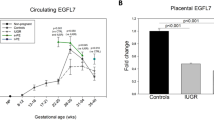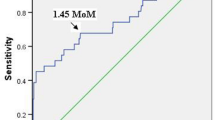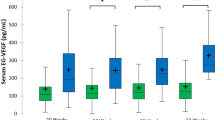Abstract
The objective of this study was to determine if the maternal serum levels of visfatin in the first trimester of pregnancy are altered in cases that develop preeclampsia (PE) and whether the levels are related to placental perfusion reflected in uterine artery pulsatility index (PI). Serum visfatin and uterine artery PI were measured at 11+0–13+6 weeks in 80 cases that developed PE and 240 unaffected controls. The median visfatin and uterine artery PI multiple of the unaffected median (MoM) in the outcome groups was compared and the significance of the association between visfatin MoM and uterine artery PI MoM, birth weight percentile and gestation at delivery was determined. In the PE group, compared with controls, there was a significantly higher median visfatin MoM (1.35, interquartile range (IQR): 0.69–2.16 vs 1.00, IQR: 0.55–1.96, P=0.027) and uterine artery PI MoM (1.19, IQR: 0.95–1.44 vs 1.03, IQR: 0.83–1.22, P<0.0001). In the PE group, there was no significant association between serum visfatin MoM and uterine artery PI MoM (P=0.589), gestation at delivery (P=0.763) or birth weight percentile (P=0.646). Serum visfatin levels at 11–13 weeks are increased in women who develop PE by a mechanism unrelated to impaired placental perfusion.
This is a preview of subscription content, access via your institution
Access options
Subscribe to this journal
Receive 12 digital issues and online access to articles
$119.00 per year
only $9.92 per issue
Buy this article
- Purchase on Springer Link
- Instant access to full article PDF
Prices may be subject to local taxes which are calculated during checkout

Similar content being viewed by others
References
Ma Y, Cheng Y, Wang J, Cheng H, Zhou S, Li X . The changes of visfatin in serum and its expression in fat and placental tissue in pregnant women with gestational diabetes. Diabetes Res Clin Pract 2010; 90: 60–65.
Fukuhara A, Matsuda M, Nishizawa M, Segawa K, Tanaka M, Kishimoto K et al. Visfatin: a protein secreted by visceral fat that mimics the effects of insulin. Science 2005; 307: 426–430.
Chen MP, Chung FM, Chang DM, Tsai JC, Huang HF, Shin SJ et al. Elevated plasma level of visfatin/pre-B cell colony-enhancing factor in patients with type 2 diabetes mellitus. J Clin Endocrinol Metab 2006; 91: 295–299.
Krzyzanowska K, Krugluger W, Mittermayer F, Rahman R, Haider D, Shnawa N et al. Increased visfatin concentrations in women with gestational diabetes mellitus. Clin Sci 2006; 110: 605–609.
Lewandowski KC, Stojanovic N, Press M, Tuck SM, Szosland K, Bienkiewicz M et al. Elevated serum levels of visfatin in gestational diabetes: a comparative study across various degrees of glucose tolerance. Diabetologia 2007; 50: 1033–1037.
Coskun A, Ozkaya M, Kiran G, Kilinc M, Arikan DC . Plasma visfatin levels in pregnant women with normal glucose tolerance, gestational diabetes and pre-gestational diabetes mellitus. J Matern Fetal Neonatal Med 2010; 23: 10–14.
Gok DE, Yazici M, Uckaya G, Bolu SE, Basaran Y, Ozgurtas T et al. The role of visfatin in the pathogenesis of gestational diabetes mellitus. J Endocrinol Invest 2011; 34: 3–7.
Mazaki-Tovi S, Romero R, Kusanovic JR, Vaisbuch E, Erez O, Than NG et al. Maternal visfatin concentration in normal pregnancy. J Perinat Med 2009; 37: 206–217.
Fasshauer M, Waldeyer T, Seeger J, Schrey S, Ebert T, Kratzsch J et al. Serum levels of the adipokine visfatin are increased in preeclampsia. Clin Endocrinol 2008; 69: 69–73.
Adali E, Yildizhan R, Kolusari A, Kurdoglu M, Bugdayc G, Sahin HG et al. Increased visfatin and leptin in pregnancies complicated by pre-eclampsia. J Matern Fetal Neonatal Med 2009; 22: 873–879.
ZulfIkaroglu E, Isman F, Payasli A, Kilic S, Mine Kucur M, Danisman N . Plasma visfatin levels in preeclamptic and normal pregnancies. Arch Gynecol Obstet 2010; 281: 995–998.
Hu W, Wang Z, Wang H, Huang H, Dong M . Serum visfatin levels in late pregnancy and pre-eclampsia. Acta Obstet Gynecol Scand 2008; 87: 413–418.
Mazaki-Tovi S, Romero R, Kim SK, Vaisbuch E, Kusanovic JP, Erez O et al. Could alterations in maternal plasma visfatin concentration participate in the phenotype definition of preeclampsia and SGA? J Matern Fetal Neonatal Med 2010; 23: 857–868.
Brosens I, Pijnenborg R, Vercruysse L, Romero R . The "Great Obstetrical Syndromes" are associated with disorders of deep placentation. Am J Obstet Gynecol 2011; 204: 193–201.
Yu CKH, Smith GCS, Papageorghiou AT, Cacho AM, Nicolaides KH . An integrated model for the prediction of preeclampsia using maternal factors and uterine artery Doppler velocimetry in unselected low risk women. Am J Obstet Gynecol 2005; 193: 429–436.
Plasencia W, Maiz N, Bonino S, Kaihura C, Nicolaides KH . Uterine artery Doppler at 11+0 to 13+6 weeks in the prediction of preeclampsia. Ultrasound Obstet Gynecol 2007; 30: 742–749.
Solomon CG, Graves SW, Greene MF, Seely EW . Glucose intolerance as a predictor of hypertension in pregnancy. Hypertension 1994; 23: 717–721.
Kaaja R, Laivuori H, Laasko M, Tikkanen MJ, Ylikorkala O . Evidence of a state of increased insulin resistance in preeclampsia. Metabolism 1999; 48: 892–896.
Lorentzen B, Birkeland KI, Endresen MJ, Henriksen T . Glucose intolerance in women with preeclampsia. Acta Obstet Gynecol Scand 1998; 77: 22–27.
Vatten LJ, Skjaerven R . Is pre-eclampsia more than one disease? BJOG 2004; 111: 298–302.
D'Anna R, Baviera G, Corrado F, Giordano D, De Vivo A, Nicocia G et al. Adiponectin and insulin resistance in early- and late-onset pre-eclampsia. BJOG 2006; 113: 1264–1269.
Robinson HP, Fleming JE . A critical evaluation of sonar ‘crown rump length’ measurements. BJOG 1975; 182: 702–710.
Snijders RJ, Noble P, Sebire N, Souka A, Nicolaides KH . UK multicentre project on assessment of risk of trisomy 21 by maternal age and fetal nuchal-translucency thickness at 10-14 weeks of gestation. Lancet 1998; 352: 343–346.
Kaagan KO, Wright D, Baker A, Sahota D, Nicolaides KH . Screening for trisomy 21 by maternal age, fetal nuchal translucency thickness, free beta-human chorionic gonadotropin, and pregnancy associated plasma protein-A. Ultrasound Obstet Gynecol 2008; 31: 618–624.
Brown MA, Lindheimer MD, De Swiet M, Van Assche A, Moutquin JM . The classification and diagnosis of the hypertensive disorders of pregnancy: statement from the International Society for the Study of Hypertension in Pregnancy (ISSHP). Hypertens Pregnancy 2001; 20: IX–XIV.
Akolekar R, Syngelaki A, Sarquis R, Zvanca M, Nicolaides KH . Prediction of early, intermediate and late pre-eclampsia from maternal factors, biophysical and biochemical markers at 11–13 weeks. Prenat Diagn 2011; 31: 66–74.
Fasshauer M, Waldeyer T, Seeger J, Schrey S, Ebert T, Kratzsch J et al. Serum levels of the adipokine visfatin are increased in pre-eclampsia. Clin Endocrinol 2008; 69: 69–73.
Egbor M, Ansari T, Morris N, Green CJ, Sibbonsa PD . Morphometric placental villous and vascular abnormalities in early- and late-onset pre-eclampsia with and without fetal growth restriction. BJOG 2006; 113: 580–589.
Ferreira AFF, Rezende JC, Vaikousi E, Akolelar R, Nicolaides KH . Maternal serum visfatin at 11–13 weeks of gestation in gestational diabetes mellitus. Clin Chem 2010; 57: 1–4.
Axelsson J, Witasp A, Carrero JJ, Quereshi AR, Suliman ME, Heimbürger O et al. Circulating levels of visfatin/pre-B-cell colony enhancing factor 1 in relation to genotype, GFR, body composition, and survival in patients with CKD. Am J Kidney Dis 2007; 49: 237–244.
Takebayashi K, Suetsugu M, Wakabayashi S, Aso Y, Inukai T . Association between plasma visfatin and vascular endothelial function in patients with type 2 diabetes mellitus. Metabolism 2007; 56: 451–458.
Anfossi G, Russo I, Doronzo G, Pomero A, Trovati M . Adipocytokines in atherothrombosis: focus on platelets and vascular smooth muscle cells. Mediators Inflamm 2010; 2010: 174341.
Yamawaki H, Hara N, Okada M, Hara Y . Visfatin causes endothelium-dependent relaxation in isolated blood vessels. Biochem Biophys Res Commun 2009; 383: 503–508.
Redman CW . Pre-eclampsia and the placenta. Placenta 1991; 12: 301–308.
Redman CW, Sacks GP, Sargent IL . Preeclampsia: an excessive maternal inflammatory response to pregnancy. Am J Obstet Gynecol 1999; 80: 499–506.
Granger JP, Alexander BT, Llinas MT, Bennett WA, Khalil RA . Pathophysiology of hypertension during preeclampsia linking placental ischemia with endothelial dysfunction. Hypertension 2001; 38: 718–722.
Ness RB, Sibai BM . Shared and disparate components of the pathophysiologies of fetal growth restriction and preeclampsia. Am J Obstet Gynecol 2006; 195: 40–49.
Nicolaides KH . Turning the pyramid of prenatal care. Fetal Diagn Ther 2011; 29: 183–196.
Acknowledgements
The study was supported by a grant from The Fetal Medicine Foundation (UK Charity No: 1037116). The assay for visfatin was performed by Ms Tracy Dew at the Department of Biochemistry, King’s College Hospital, London, UK.
Author information
Authors and Affiliations
Corresponding author
Ethics declarations
Competing interests
The authors declare no conflict of interest.
Rights and permissions
About this article
Cite this article
Ferreira, A., Rezende, J., de Cassia C. Oliveira, R. et al. Maternal serum visfatin at 11–13 weeks’ gestation in preeclampsia. J Hum Hypertens 27, 261–264 (2013). https://doi.org/10.1038/jhh.2012.10
Received:
Revised:
Accepted:
Published:
Issue Date:
DOI: https://doi.org/10.1038/jhh.2012.10



